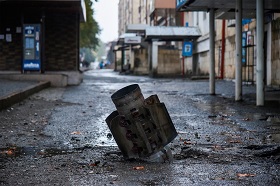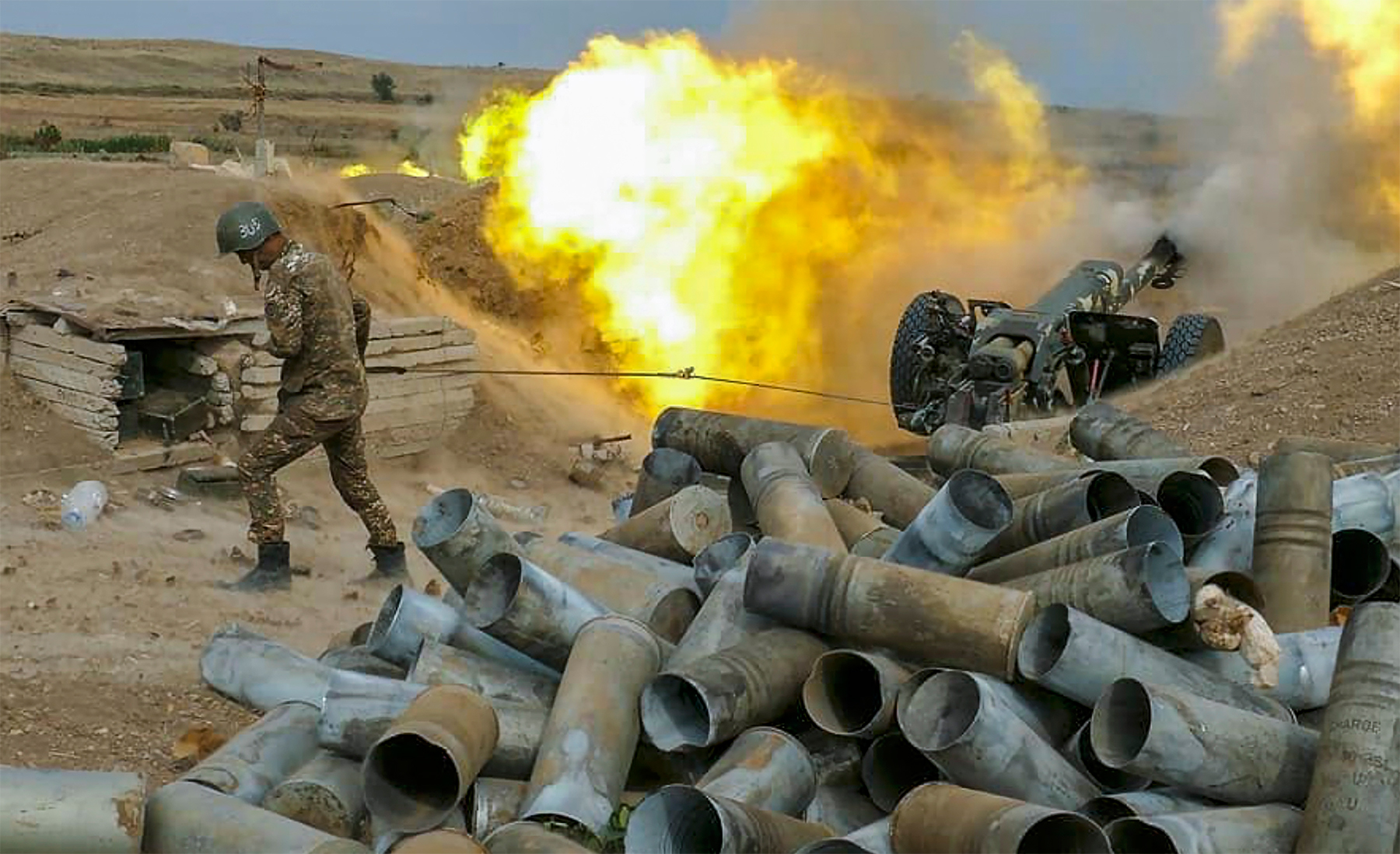In his book “The Clash of Civilizations and the Remaking of World Order”, Samuel Huntington cited the Nagorno-Karabakh conflict to illustrate the transition of world order and regime changes after the Cold War. However, contrary to Huntington’s belief, conflicts and wars in the Caucasus, including those in Nagorno-Karabakh, Chechnya, Abkhazia and South Ossetia are more of ethnical than religious nature. In resolving the Nagorno-Karabakh conflict, elites of different ethnic groups have made numerous efforts to mobilize the masses by bringing up religious sentiments in Afghan and Christian Mujahedeen. However, the ethnic conflict between Armenians and Azeris has always been more troublesome than the religious dispute between Christians and Muslims.
However, the Nagorno-Karabakh conflict of the last decade and the recent military encounter between Armenia and the Republic of Azerbaijan of this year are different from conflicts in the early 1990s. One of the reasons is the rise of extremist groups in the 21st century.
With such extended and superficial understanding from the concept of jihadism, the Nagorno-Karabakh conflict goes beyond the ethnic-territorial dispute between Azeris and Armenians, for religious disputes in the region would ultimately lead to the “Kishmirization of the Nagorno-Karabakh conflict”. With the addition of religious conflicts, more violence and human casualties would occur, and the prospects for durable peace in the region would be bleaker than before in the area. Although thousands of people have lost their lives in the Nagorno-Karabakh conflict and in bitter incidences such as the massacres in Khojaly and Sumgait in the past three decades, the Caucasus has never seen the crimes as violent as the ones committed in Syria and Iraq against the Izadi and Kurdish minorities.
In the meantime, extremists in Georgia and North Caucasus of Russia might also expand their domain as they did in the early 1990s. Under the current circumstances, Iran’s national security are under challenges because of its geographical proximity with the Nagorno-Karabakh conflict. The conflict might lead to security threats from the terrorist and takfiri groups, whose anti Shia and anti-Iranian attitudes manifested in the Syrian Civil War. In recent years, the Khoda Afarin village in the border of East Azerbaijan with Armenia received the artilleries, shells and missiles fired between Armenia and Azerbaijan in their border conflicts in both April 2016 and September this year. As a result, together with Iraq, Iran might decisively take actions against the takfiri and jihadist groups should bullets and shells from the Nagorno-Karabakh conflict continue to fall into Iran's northwestern borders.
In his book “The Clash of Civilizations and the Remaking of World Order”, Samuel Huntington used the example of the Nagorno-Karabakh conflict to demonstrate the conflict between the Christians and Muslims and civilizational clashes. When Huntington was writing his book in the 1990s, Armenia and the Republic of Azerbaijan were fighting over Nagorno-Karabakh. The American thinker cited this conflict, together with the Balkan conflict to illustrate the transition of world order and regime changes after the Cold War. However, contrary to Huntington’s belief, conflicts and wars in the Caucasus, including those in Nagorno-Karabakh, Chechnya, Abkhazia and South Ossetia are more of ethnical than religious nature. In resolving the Nagorno-Karabakh conflict, elites of different ethnic groups have made numerous efforts to mobilize the masses by bringing up religious sentiments in Afghan and Christian Mujahedeen. However, the ethnic conflict between Armenians and Azeris has always been more troublesome than the religious dispute between Christians and Muslims.
However, the Nagorno-Karabakh conflict of the last decade and the recent military encounter between Armenia and the Republic of Azerbaijan of this year are different from conflicts in the early 1990s. One of the reasons is the rise of extremist groups in the 21st century.
The crises in Syria and Iraq and the presence of Salafi, Takfiri and Wahhabi forces in the past decade has brought extremist groups such as the Al-Nosra Front and ISIS in Syria and Iraq to the Caucasus region. The belief system and apparatus of these extremist groups are closely connected to the religious beliefs in North Caucasus (Chechnya, Ingush and Dagestan), especially in the Islamic Emirate of Caucasus. Because of their belief system, the Caucasian members of the Salafi and jihadi groups have become the third most killed group in the Syrian Civil War, after Saudi Arabian and Egyptian citizens. One decade after the eruption of Syria and Iraq crises, the Salafi and jihadi groups, mainly ISIS and Al-Nosra Front, have lost the majority of their controlled territories. Their losses have left them with three new choices to rebuild their military basis and continue their activities: Afghanistan, Yemen and Libya.
Given the tensions in the Caucasus and between Armenia and the Republic of Azerbaijan, it turns out that the Caucasus has attracted the attention of the Salafi and Jihadi groups and might become their next military base after Afghanistan, Yemen and Libya. The issue has become urgent under the conditions of intensified Turkey-Russia rivalries in Syria and Libya. As a result, the involvement of the Syria Free Army and Syrian Turkmens in the territorial conflict of Nagorno-Karabakh has further complicated the regional conflict, for many people fear that the presence of Jihadis and Takfiris may cause an ethnoreligious dispute in the region.
It should be noted that in comparison with the primary principles of Islam, the concept of jihadism in the Salafi and takfiri thoughts is more than a secondary jurisprudential decree. Takfiris believe that assassinating enemies of Allah is essential to the creation of an Islamic government. Another feature of jihadism is its instrumentalization. Contrary to Sunni jurisprudence that only the ulama can grant permission for jihadism, the takfiri jihad movement has promoted Jihadism and made it an effective tool to fight against their enemies. The Jihadi leaders who are lack of competence and academic degree for becoming traditional ulamas see themselves entitled to Jihadism. They believe that Jihad is an obligatory affair overlooked by Muslims. For example, Abdullah Azzam, a Salafi scholar and a jihadi leader in Afghanistan who is known as the intellectual father of al-Qaida, underlines that Muslims have a wrong understanding of Jihadism. Contrary to Muslims who believe that Jihadism is a religious guide for them to serve god in daily life, such as delivering sermons and helping the family and parents, Azzam believes that the only meaning of Jihadism is to fight. Azzam’s definition of Jihad allows power-thirsty religious leaders to take advantage of the religious interests among Muslim youths to realize their political goals.
With such extended and superficial understanding from the concept of jihadism, the Nagorno-Karabakh conflict goes beyond the ethnic-territorial dispute between Azeris and Armenians, for religious disputes in the region would ultimately lead to the “Kishmirization of the Nagorno-Karabakh conflict”. With the addition of religious conflicts, more violence and human casualties would occur, and the prospects for durable peace in the region would be bleaker than before in the area. Although thousands of people have lost their lives in the Nagorno-Karabakh conflict and in bitter incidences such as the massacres in Khojaly and Sumgait in the past three decades, the Caucasus has never seen the crimes as violent as the ones committed in Syria and Iraq against the Izadi and Kurdish minorities.
Another important point is that if jihadists fight against Christian Armenians and non-Muslims, the Shia populations of the Republic of Azerbaijan will be accused of takfir and apostasy. The bitter experiences of Afghan, Syrian and Iraqi Muslims have indicated that the accusation of paganism and apostasy by the extremist groups, will provoke Muslim extremism in Shias. Among the extremist groups, Salafi and Takfiri accuse Muslims of takfir and execute them without asking for permission from the Sunni Ulamas. Therefore, the presence of the Salafi and Jihadi groups would be a Damocles Sword which threatens the Shia society of the Republic of Azerbaijan in the long run. In turn, countries in the region, such as Turkey and the Republic of Azerbaijan, have become particularly aware of such threats.
In the meantime, extremists in Georgia and North Caucasus of Russia might also expand their domain as they did in the early 1990s. Under the current circumstances, Iran’s national security are under challenges because of its geographical proximity with the Nagorno-Karabakh conflict. The conflict might lead to security threats from the terrorist and takfiri groups, whose anti Shia and anti-Iranian attitudes manifested in the Syrian Civil War. For this reason, Iranian officials such as President Hassan Ruhani and Ali Akbar Velayati, the international relations advisor to the Supreme Leader, have warned against the danger of takfiri and jihadi groups on Iran’s border. Thus, if the military clash between Armenia and the Republic of Azerbaijan continues, the presence of takfiri and terrorist groups in the Nagorno-Karabakh conflict increases, and the level of threats increases, Iran is likely to take actions to secure their northwest borders. In 2015, Iran formally declared that forty kilometers to its borders with Iraq is the red line that the Salafi and terrorist groups cannot cross. In addition, the Khoda Afarin village in the border of East Azerbaijan with Armenia received the artilleries, shells and missiles fired between Armenia and Azerbaijan in their border conflicts in both April 2016 and September this year. As a result, together with Iraq, Iran might decisively take actions against the takfiri and jihadist groups should bullets and shells from the Nagorno-Karabakh conflict continue to fall into Iran's northwestern borders.






